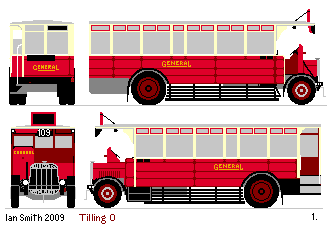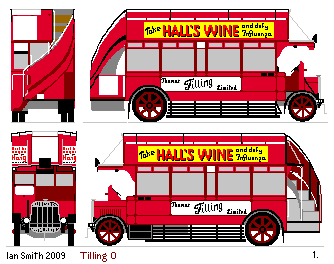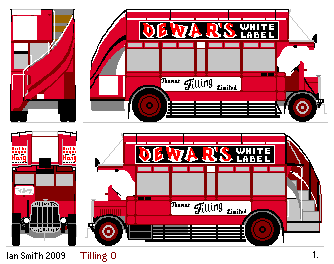
Thomas Tilling O CLASS
Tilling-Stevens Petrol-Electric Buses
This page prepared by Ian Smith, created 26thSeptember 2009.
O1-O166It was 1923. Thomas Tilling Ltd, operating buses from Catford and Croydon, entered into an agreement with the "Combine", the London General Omnibus Company, for the purchase and operation of a new class of petrol-electric buses: LGOC would buy them; Tillings would operate them. A pooling agreement covered the operating finances. These joint buses were numbered in a separate series, with fleet numbers on the chassis frame.
Bodywork was constructed by Tillings at its own factories in Lewisham (121) and Lee (47). They seated 48: 26 on top and 22 inside - literally, as this was still the period of open-top buses with solid tyres and no drivers' windscreens. The driver enjoyed a forward control cab on the offside of the petrol engine, while the top deck cantilevered forward over his head.
The fleet of new buses required more garages: The LGOC offered new garages at Bromley and Sidcup.
Tillings accepted the Bromley Garage, which became known as Tillings Bromley (TB), and declined one at Sidcup.
Instead LGOC considerably enlarged Catford, which was called Tillings Lewisham (TL).
Into serviceTillings operated tight financial oversight of its fleet, and allocated the buses to specific routes and indeed specific duties, with designated spares.O1-O10 went into operation on the 21A (Wood Green - Shooters Hill (Eltham)) in July 1923, working from Catford. O11 was a designated spare at Catford for this cohort. The new buses operated alongside General's S-types from Palmers Green and Old Kent Road. O12-O16 were placed on the longer 21B (Wood Green - Farningham) in August, followed by O17-O21 on the 21 (Wood Green - Sidcup) in September. O22 was the designated spare. O23-O28 went onto the 36 (West Kilburn - Hither Green) at Catford in October, displacing older buses for service enhancements over at Croydon. O29-O32 were added to the 21A contingent in October, with O33 as a spare, closely followed by O34-O38 for the 21. Two of the route 36 O-types were also transferred to the 21. Five more new ones, O39-O43 were also added to the 21 group as extras, with O44 as a spare. Route 47 (Shoreditch - London Bridge - Deptford - Lewisham - Catford - Bromley - Farnborough) was the next to receive the new buses, starting in November, with O45-O49, O50 as spare, and O51-O55. O56-O70 followed in December, initiating a widespread cascade of displaced older buses onto other routes. January 1924 saw a small batch, O71-74 join the route 36 contingent. A new weekday route 66 was set up jointly by Tillings and LGOC to compliment the existing Sunday service between Bostall Woods and Bromley Common, to compete with a Timpsons service. LGOC provided 12 buses from Plumstead, Tillings six new TS7s: O75-80. The route required more input from both companies in March, Tilling supplying O81-O87. Bromley garage opened in April 1924, occasioning a significant reshuffle. Bromley took over routes 47 and 66 from Catford (plus some of LGOC's responsibility from Dalston). O70-O87 were transferred from Catford, and new O88-O123 joined them. O70-O104 were allocated to the 47, with O105-O106 as spares, and O107-O122 went to the 66, with O123 as spare. Back at Catford the TS7s from the 47 were redistributed, going onto the 12B (East Acton - Lower Sydenham), jointly with LGOC, the 136 (Lewisham - Bromley - Keston - Westerham Hill) and route 1 (Willesden - Lewisham). Bromley received more new TS7s in May 1924, displacing O71-O86 to Catford for the 36A (British Empire Exhibition, Wembley - Grove Park)), which Tilling increasingly took over from the LGOC, and which took the Tilling buses to the new Wembley bus station for the first time. O80 was the spare. LGOC's Sidcup Garage opened in June. LGOC took over the 21 and 21B, and withdrew the 66. Catford put three more TS7s on the 21, and put twelve on the 36 in place of General buses. The nine buses on the 136 were transferred to Bromley. There were still eighteen buses unaccounted for at Catford, including five TS7s, but these found a home sharing the 78 (Shoreditch - Dulwich), previously with the LGOC. Bromley received another six O-types, which it used on the 36, despite the long garage run involved. In August 1924 Bromley received another eight, also for the 36, which released eight of Catford's earlier TS7s for use on the 12A (Oxford Circus - South Croydon). Bromley released O87-O93 to Catford for use as spares. The last TS7, O166, was delivered to Bromley in September. Winter service reductions, including withdrawal of the exhibition extensions to Wembley, allowed TS7s to be used by Catford on the route 12 short journeys (Oxford Circus - Dulwich). Co-operative changes of allocations between LGOC and Tillings continued, to try to take account of rapidly expanding London and changing demographics, and to produce economical and effective working. In December 1924 the Metropolitan Police instituted a new system of numbering bus routes - the Bassom system, whereby various short-workings of routes all received separate route number suffixes, and all route variants received separate route numbers. This did not much affect the TS7s, except that the 136 became the 146 and 146A, the 78 became the 78A, the 21A became the 20 and various other routes changed their suffixes. A new 136A appeared (West Kilburn - Grove Park (via Lee Green)), with new single-deck route 136D between Lewisham and Bromley Common, but both of these were worked by the LGOC. Summer of 1925 saw an increased requirement, as summer trippers wanted to get out into the country beyond "The Smoke". The 47 to Green Street Green, with a half-hourly service to the far point during the week, needed an eight-minute headway on Sundays! The extra buses were found by letting the LGOC operate the 146 and 146A.
The TS7s lasted until new AEC Regents transformed the scene at the beginning of the 1930s. The newer buses had more than a slight edge in terms of performance. Eighty TS7s were withdrawn in 1932,
and twenty-five TS7s were fitted with pneumatic tyres to improve their performance. When new ST types arrived at Bromley they first displaced older buses taken over from Timpsons,
TS7s taking over their work on the 289A.
But then TS7s started going to Catford for the 78A, and to Croydon to replace older petrol-electrics on the 59B and 75.
By the summer of 1931 TS7s were working the 289 and 136 at Bromley, the 1C, 21A, 136, 75, and 78A at Catford, and the Sunday 49C, 59B and 75 from Croydon.
Routes 49C, 75 and 136 still required open-top buses because of overhanging trees or lamp-posts in the Borough of Lewisham.
(Imagine trying to get a safety case for that today! - top-deck travel was quite an adventure in those days!)
Then in 1931 the TS7s were introduced to the 254 (South Croydon - Croham Heights), which required open-toppers because of a low railway bridge!
Conductors had to warn upper-deck passengers to remain seated while the bus passed under.
Forty-five TS7s remained in service at the time of the LPTB take-over of Tillings in October 1933, thirty at Catford for the 1C, 20D and 112C (all peak hour extras) and fifteen at Croydon for the 59B and 254. None remained at Bromley. They did not survive long under the new regime: London Transport rushed STs into Catford, displacing not only the O-type but the Tilling STs, the latter going to Croydon to push out most of the TS7s there. By the month after the takeover only the few required for the 254 remained. By the end of January LT remembered the five open-top STLs acquired from Pickup, and sent them to Croydon to oust the O-type. Nine were converted to tower wagons, and others were sold to showmen, who presumably found the built-in generator a useful feature. O167: the Bromley lorryO167 was the Bromley garage lorry, a TS7 chassis fitted with a lorry body.
O168-O179: the single-deckersLike the double-deckers these twelve buses were bought by LGOC to be operated by Tillings. In this case it was for the 109 route (Penge - Beckenham - Shortlands - Chislehurst), which required single-deckers to negotiate the Chislehurst Water Tower and Shortlands Railway Bridge. The single-deckers were TS7 petrol-electrics with 30-seater bodies built by Tillings. They replaced single-decker B-types that had been operated by Tilling on behalf of the LGOC since May 1924. The new buses, painted in LGOC livery with General fleetnames, were delivered to start service in October 1925. They were fitted with pneumatic tyres in the summer of 1929, and in 1930 were relicensed by Tillings and repainted in Tillings livery. The Tilling Regals took over from them in the autumn of 1932.
|
 The 166 buses were Tilling-Stevens TS7 petrol-electrics:
a petrol engine drove a generator which provided electricity to drive an electric motor to drive the bus.
This was not a novel arrangement for Tillings,
who had operated earlier petrol-electrics since 1911. Wheelbase was 14ft9in.
The 166 buses were Tilling-Stevens TS7 petrol-electrics:
a petrol engine drove a generator which provided electricity to drive an electric motor to drive the bus.
This was not a novel arrangement for Tillings,
who had operated earlier petrol-electrics since 1911. Wheelbase was 14ft9in.

 Ian's Bus Stop
Ian's Bus Stop Tilling Stevens O: text
Tilling Stevens O: text bus histories
bus histories